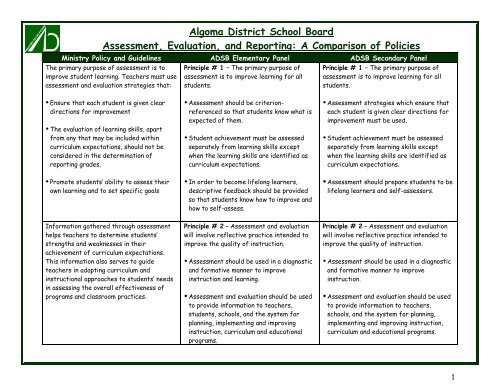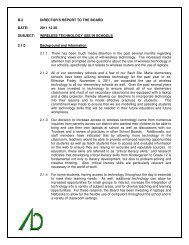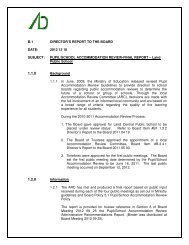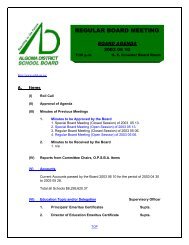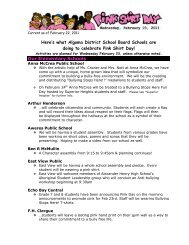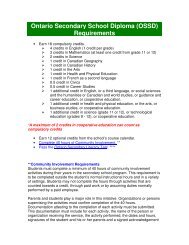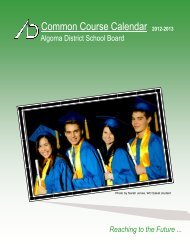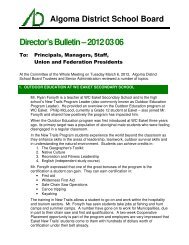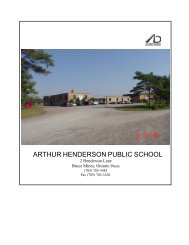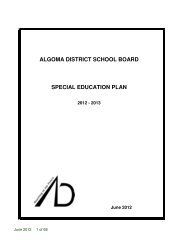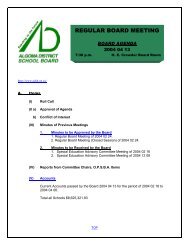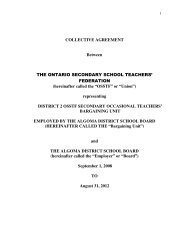Algoma District School Board Assessment, Evaluation, and Reporting
Algoma District School Board Assessment, Evaluation, and Reporting
Algoma District School Board Assessment, Evaluation, and Reporting
- No tags were found...
You also want an ePaper? Increase the reach of your titles
YUMPU automatically turns print PDFs into web optimized ePapers that Google loves.
<strong>Algoma</strong> <strong>District</strong> <strong>School</strong> <strong>Board</strong><strong>Assessment</strong>, <strong>Evaluation</strong>, <strong>and</strong> <strong>Reporting</strong>: A Comparison of PoliciesMinistry Policy <strong>and</strong> Guidelines ADSB Elementary Panel ADSB Secondary PanelThe primary purpose of assessment is toimprove student learning. Teachers must useassessment <strong>and</strong> evaluation strategies that:Principle # 1 – The primary purpose ofassessment is to improve learning for allstudents.Principle # 1 – The primary purpose ofassessment is to improve learning for allstudents.• Ensure that each student is given cleardirections for improvement• The evaluation of learning skills, apartfrom any that may be included withincurriculum expectations, should not beconsidered in the determination ofreporting grades.• <strong>Assessment</strong> should be criterionreferencedso that students know what isexpected of them.• Student achievement must be assessedseparately from learning skills exceptwhen the learning skills are identified ascurriculum expectations.• <strong>Assessment</strong> strategies which ensure thateach student is given clear directions forimprovement must be used.• Student achievement must be assessedseparately from learning skills exceptwhen the learning skills are identified ascurriculum expectations.• Promote students’ ability to assess theirown learning <strong>and</strong> to set specific goals• In order to become lifelong learners,descriptive feedback should be providedso that students know how to improve <strong>and</strong>how to self-assess.• <strong>Assessment</strong> should prepare students to belifelong learners <strong>and</strong> self-assessors.Information gathered through assessmenthelps teachers to determine students’strengths <strong>and</strong> weaknesses in theirachievement of curriculum expectations.This information also serves to guideteachers in adapting curriculum <strong>and</strong>instructional approaches to students’ needsin assessing the overall effectiveness ofprograms <strong>and</strong> classroom practices.Principle # 2 – <strong>Assessment</strong> <strong>and</strong> evaluationwill involve reflective practice intended toimprove the quality of instruction.• <strong>Assessment</strong> should be used in a diagnostic<strong>and</strong> formative manner to improveinstruction <strong>and</strong> learning.• <strong>Assessment</strong> <strong>and</strong> evaluation should be usedto provide information to teachers,students, schools, <strong>and</strong> the system forplanning, implementing <strong>and</strong> improvinginstruction, curriculum <strong>and</strong> educationalprograms.Principle # 2 – <strong>Assessment</strong> <strong>and</strong> evaluationwill involve reflective practice intended toimprove the quality of instruction.• <strong>Assessment</strong> should be used in a diagnostic<strong>and</strong> formative manner to improveinstruction.• <strong>Assessment</strong> <strong>and</strong> evaluation should be usedto provide information to teachers,schools, <strong>and</strong> the system for planning,implementing <strong>and</strong> improving instruction,curriculum <strong>and</strong> educational programs.1
<strong>Algoma</strong> <strong>District</strong> <strong>School</strong> <strong>Board</strong><strong>Assessment</strong>, <strong>Evaluation</strong>, <strong>and</strong> <strong>Reporting</strong>: A Comparison of PoliciesMinistry Policy <strong>and</strong> Guidelines ADSB Elementary Panel ADSB Secondary Panel<strong>Assessment</strong> <strong>and</strong> evaluation will be based onthe provincial curriculum expectations <strong>and</strong>the achievement levels outlined in theMinistry <strong>Assessment</strong> <strong>and</strong> <strong>Evaluation</strong>document (secondary) <strong>and</strong> in the curriculumdocuments for each discipline or subjectarea.In all areas of learning, students must beprovided with numerous <strong>and</strong> variedopportunities to demonstrate the fullextent of their achievement of thecurriculum expectations, across all fourcategories of knowledge <strong>and</strong> skills.Principle # 3 – <strong>Assessment</strong> <strong>and</strong> evaluationmust be based on the Ontario ProvincialCurriculum Expectations, AchievementCharts <strong>and</strong> Exemplars.• <strong>Assessment</strong> <strong>and</strong> evaluation must be basedon the four categories of knowledge <strong>and</strong>skills (see chart) <strong>and</strong> on the descriptionsgiven in the achievement chart thatappears in each curriculum document.• <strong>Assessment</strong> should provide variedopportunities for students to demonstratecompetence in the Ontario CurriculumExpectations; thereby addressingindividual student learning styles.Principle # 3 – <strong>Assessment</strong> <strong>and</strong> evaluationmust be based on the Ontario ProvincialCurriculum Expectations, AchievementCharts <strong>and</strong> Exemplars.• <strong>Assessment</strong> <strong>and</strong> evaluation must be basedon the four categories of knowledge <strong>and</strong>skills <strong>and</strong> on the descriptions given in theachievement chart that appears in thecurriculum policy document for eachdiscipline.• <strong>Assessment</strong> should provide opportunitiesto demonstrate competence in the OntarioCurriculum Expectations• Classroom assessment will help preparestudents to be successful on curriculumbased provincial tests.2
<strong>Algoma</strong> <strong>District</strong> <strong>School</strong> <strong>Board</strong><strong>Assessment</strong>, <strong>Evaluation</strong>, <strong>and</strong> <strong>Reporting</strong>: A Comparison of PoliciesMinistry Policy <strong>and</strong> Guidelines ADSB Elementary Panel ADSB Secondary Panel<strong>Assessment</strong> <strong>and</strong> evaluation strategies must:• Be varied in nature, administered over aperiod of time, <strong>and</strong> designed to provideopportunities for students todemonstrate the full range of theirlearning;• Be appropriate for the learning activitiesused, the purposes of instruction, <strong>and</strong> theneeds <strong>and</strong> experiences of students;• Be fair to all students;• Accommodate the needs of exceptionalstudents, consistent with the strategiesoutlined in their Individual Education Plan;• Accommodate the needs of students whoare learning the language of instruction.Principle # 4 – <strong>Assessment</strong>, evaluation, <strong>and</strong>grading must be meaningful, fair, <strong>and</strong>consistent. It should measure that which itis intended to measure. Strategies must:• Be varied in nature, be administered overa period of time, <strong>and</strong> be designed toprovide opportunities for students todemonstrate the full range of theirlearning;• Be appropriate for the learning activitiesused, the purposes of instruction, <strong>and</strong> theneeds <strong>and</strong> experiences of the students;• Accommodate the needs of exceptionalstudents, consistent with the strategiesoutlined in their Individual Education Plan;• Reflect Ontario Curriculum Expectations,Achievement Charts, Exemplars <strong>and</strong>Provincial Policy;• Address the processes <strong>and</strong> products ofstudent work;• Ensure that procedures used for dealingwith late assignments be fair <strong>and</strong>consistent;• Access summative assessment data uponwhich to base report card grades.Principle # 4 – <strong>Assessment</strong>, evaluation, <strong>and</strong>grading must be meaningful, fair,consistent, reliable <strong>and</strong> valid. <strong>Assessment</strong>strategies must:• Be varied in nature, be administered overa period of time, <strong>and</strong> be designed toprovide opportunities for students todemonstrate the full range of theirlearning including their improvement;• Be appropriate for the learning activitiesused, the purposes of instruction, <strong>and</strong> theneeds <strong>and</strong> experiences of the students;• Accommodate the needs of exceptionalstudents, consistent with the strategiesoutlined in their Individual Education Plan;• Reflect Ontario Curriculum Expectations,Achievement Charts, Exemplars <strong>and</strong>Provincial Policy;• Address the processes <strong>and</strong> products ofstudent work;• Ensure that procedures used for dealingwith late assignments be fair <strong>and</strong>consistent;• Provide evidence that will be the basis forthe final grade.3
<strong>Algoma</strong> <strong>District</strong> <strong>School</strong> <strong>Board</strong><strong>Assessment</strong>, <strong>Evaluation</strong>, <strong>and</strong> <strong>Reporting</strong>: A Comparison of PoliciesMinistry Policy <strong>and</strong> Guidelines ADSB Elementary Panel ADSB Secondary Panel<strong>Assessment</strong> <strong>and</strong> evaluation strategies mustbe communicated clearly to students <strong>and</strong>parents at the beginning of the course(term/year) <strong>and</strong> at other appropriate pointsthroughout the course (term/year).Principle # 5 – Communication to all partiesmust be timely, appropriate <strong>and</strong> based onthe Ontario Provincial CurriculumExpectations <strong>and</strong> the Achievement Charts.Communication strategies must:Principle # 5 – Communication to all partiesmust be timely, appropriate <strong>and</strong> based onthe Ontario Provincial CurriculumExpectations <strong>and</strong> the Achievement Charts.Communication strategies must:As part of assessment, teachers providestudents with the descriptive feedback thatguides their effort towards improvement.Teachers must use assessment <strong>and</strong>evaluation strategies that:• Are based both on the categories ofknowledge <strong>and</strong> skills <strong>and</strong> on theachievement level descriptions given in theachievement chart in each curriculumdocument;• Ensure that each student is given cleardirection for improvement;• Address both what students learn <strong>and</strong> howwell they learn;• Include the use of samples of students’work that provide evidence ofachievement.• Provide clear <strong>and</strong> age-appropriateinformation about assessment strategies<strong>and</strong> evaluation to students at the beginningof each unit of learning;• Provide clear <strong>and</strong> appropriate informationabout assessment strategies <strong>and</strong>evaluation to parents / guardians at thebeginning of the year <strong>and</strong> at otherappropriate times throughout the year;• Provide on-going feedback to all parties(students, parents / guardians, teachers<strong>and</strong> administrators) regarding attainmentof, <strong>and</strong> progress towards, theexpectations;• Include the use of samples of students’work to provide evidence of theirachievement.• Provide clear information to students <strong>and</strong>parent/guardians at the beginning of eachcourse <strong>and</strong> at other appropriate pointsthroughout the course about assessmentstrategies <strong>and</strong> evaluation;• Provide feedback to all parties (students,parents / guardians, teachers <strong>and</strong>administrators) regarding attainment of,<strong>and</strong> progress towards, the expectations;• Include the use of samples of students’work to provide evidence of theirachievement.4
<strong>Algoma</strong> <strong>District</strong> <strong>School</strong> <strong>Board</strong><strong>Assessment</strong>, <strong>Evaluation</strong>, <strong>and</strong> <strong>Reporting</strong>: A Comparison of PoliciesMinistry Policy <strong>and</strong> Guidelines ADSB Elementary Panel ADSB Secondary PanelAll parties must have a clear underst<strong>and</strong>ingof the specific roles <strong>and</strong> responsibilities ofall individuals involved in the assessment <strong>and</strong>evaluation process (Section 8 of OSS 1999,Program Planning <strong>and</strong> <strong>Assessment</strong>, pp. 13-18,Choices Into Action, pp. 26-29, Guide to theProvincial Report Card, <strong>and</strong> the EducationAct),Teachers must use assessment <strong>and</strong>evaluation strategies that promote students’ability to assess their own learning <strong>and</strong> toset specific goals.Principle # 6 Roles in <strong>and</strong> responsibilitiesfor assessment, evaluation <strong>and</strong> reportingmust be clearly defined <strong>and</strong> communicatedto promote underst<strong>and</strong>ing by all parties –students, parents/guardians, teachers,administrators, school councils, <strong>Board</strong> <strong>and</strong>Ministry.• All parties must have a clearunderst<strong>and</strong>ing of the specific roles <strong>and</strong>responsibilities of all individuals involved inthe assessment <strong>and</strong> evaluation process;• Students, parents, teachers <strong>and</strong> schooladministrators have significant roles toplay in the assessment <strong>and</strong> reportingprocess;• All parties must share the responsibilityfor ensuring that assessment <strong>and</strong>evaluation practices are consistent withthese Principles <strong>and</strong> Procedures;• Communication must ensure theconfidentiality of individual student datasubject to legal requirements;• <strong>Evaluation</strong> is the responsibility of theteacher. Students should be givenopportunities to develop skills in goalsetting <strong>and</strong> self <strong>and</strong> peer assessment;• <strong>Assessment</strong>, <strong>Evaluation</strong> <strong>and</strong> <strong>Reporting</strong>practices must reflect staff collaboration<strong>and</strong> dialogue regarding consistency <strong>and</strong>application of the <strong>Board</strong>’s Principles <strong>and</strong>Procedures.Principle # 6 Roles in <strong>and</strong> responsibilitiesfor assessment, evaluation <strong>and</strong> reportingmust be clearly defined <strong>and</strong> communicatedto promote underst<strong>and</strong>ing by all parties –students, parents/guardians, teachers,administrators, school councils, <strong>Board</strong> <strong>and</strong>Ministry.• All parties must have a clearunderst<strong>and</strong>ing of the specific roles <strong>and</strong>responsibilities of all individuals involved inthe assessment <strong>and</strong> evaluation process;• Students, parents, teachers <strong>and</strong> schooladministrators – all have significant rolesto play in the assessment <strong>and</strong> reportingprocess;• All parties must share the responsibilityfor ensuring that assessment <strong>and</strong>evaluation practices are consistent withthese Principles <strong>and</strong> Procedures;• Communication must ensure theconfidentiality of individual student datasubject to legal requirements;• Students should be given opportunities todevelop skills in goal setting <strong>and</strong> self <strong>and</strong>peer assessment, but evaluation is theresponsibility of the teacher;• <strong>Assessment</strong>, <strong>Evaluation</strong> <strong>and</strong> <strong>Reporting</strong>practices must reflect staff collaboration<strong>and</strong> dialogue regarding consistency <strong>and</strong>application of the <strong>Board</strong>’s Principles <strong>and</strong>Procedures.5


